The Bottomless Lake in the 11th District is located south of Gellért Hill on the so-called Lágymányos plain, the plane of which was created by the Danube. The unregulated river carried clay to the site, so in the 1850s, a brick factory began operating on the site of today's Kosztolányi Dezső Square.
During the extraction of the clay in 1877, workers accidentally cut through a deep watercourse and the stratum water burst. The factory operated for another 12 years, until it was closed in 1889 by the Budapest Public Works Council. The clay pit was already filled with stratified water by then, so clay mining became impossible in part of the area anyway. This is how today's Bottomless Lake was created, which at the time was larger than the current 1.1-acre lake.

The Bottomless Lake in 1966 (Source: Fortepan/No.: 115077)
The Cistercian monks settled in Buda in 1912, and from the capital they got an empty area for their school, church and convent on the side of Gellért Hill, on Villányi Road. However, due to World War II, construction did not begin on the site until 1924. Gyula Wälder designed the school-church-convent complex directly on the hillside, so the side of the hill had to be demolished. The land extracted from the hillside was poured into the neglected and unused lake.
Among the buildings next to the lake, Szent Imre High School was completed in 1929, and St. Emeric Parish Church was consecrated in 1938.
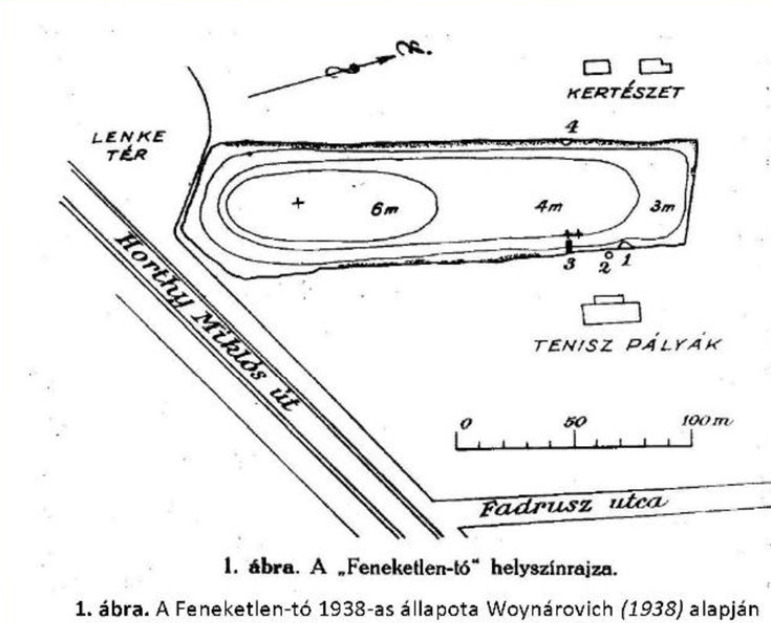
Topography of the Bottomless Lake in 1938 (Source: oszk.hu)
From this time comes a story that explains the origin of the name of the lake:
“Old people from Lágymányos say that when the Cistercian church and high school was built, they wanted to fill in the lake with the land they had extracted from the hillside. This failed, but much of the soil carried floated in the water, so the depth could not be measured, i.e., the lake is bottomless. The lake is 17 metres deep according to engineers. Yet we witnessed a rare moment: an urban legend was born in the 20th century, in a big city. ”
- writes in her local history researches Dr. Lajosné György on the birth of the name Bottomless Lake.
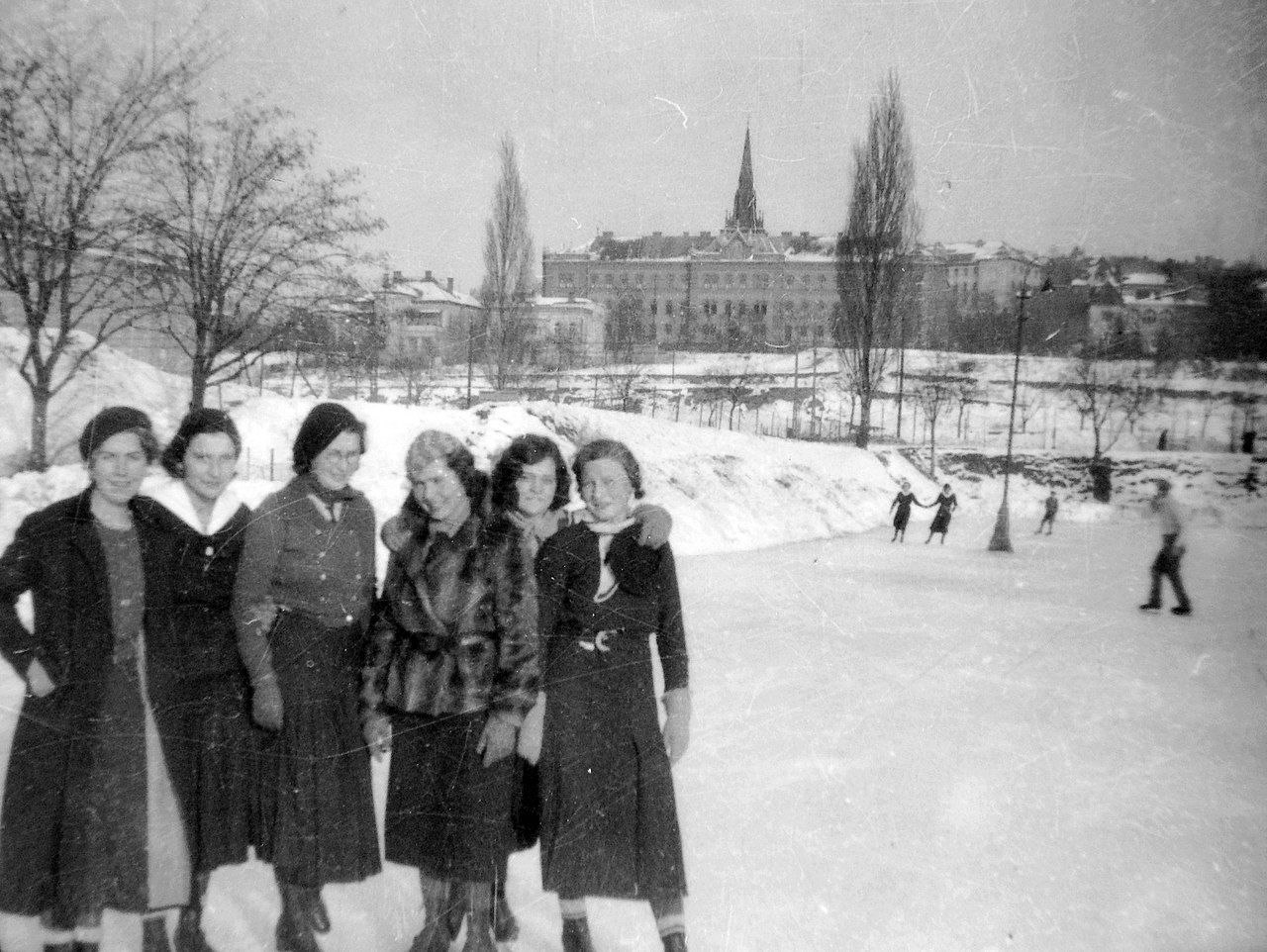
The tennis courts next to the Bottomless Lake, neighbouring Fadrusz Street, operated as skating rinks in the winter. Picture taken around 1936 (Photo: Fortepan/No.: 9547)
According to another legend, an old fisherman used the bottomless name first:
“There used to be a huge brick factory. It was the largest in the world, a lot of people worked in it, and the chimney smoked day and night. The people argued, hurting each other, and so water burst from the land and swallowed it all up. Now they work underwater and can never come up again. The water above them is like a mirror, only bubbling once or twice. Old fisherman sitting in his boat, said the lake is bottomless. It is all-absorbing deep and bottomless. For years, loads of trash have been dumped in it, but it absorbs everything and stays smooth”
- says the hero of Endre Fejes's short story, The Liar, about the lake.
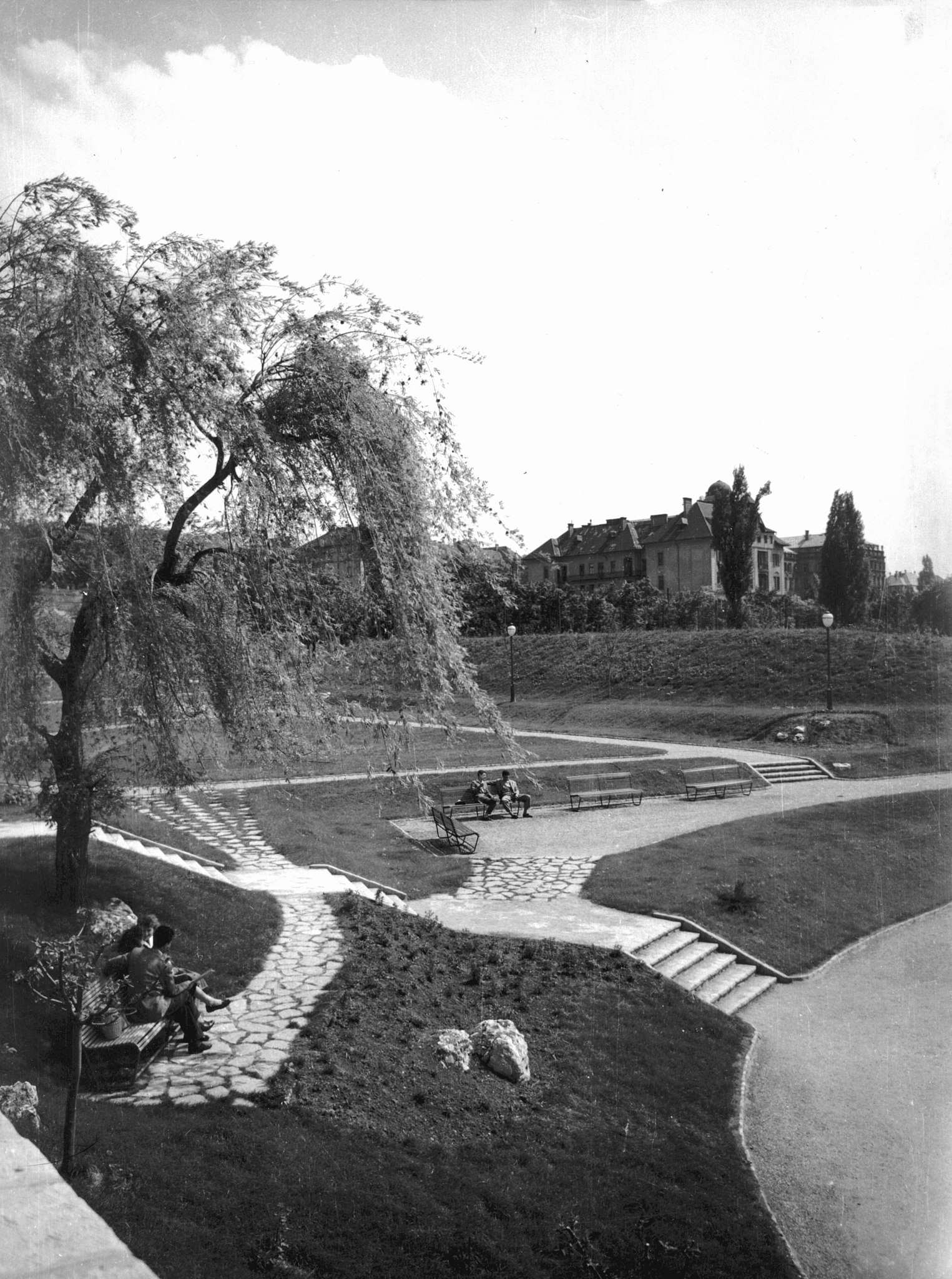
The park built around the Bottomless Lake, in 1960 (Source: Budapest Archives, Reference No.: HU_BFL_XV_19_c_11)
The lake has been surrounded by wire fencing since the 1930s, and although it was clearly visible from Kosztolányi Dezső Square (Lenke Square) and Bartók Béla Square (Átlós Square), it was inaccessible. At that time, one of the sides of the lake reached Bartók Béla Road. But at the time, the area was not yet highly valued, as the water needed to clean the tennis courts that had been operating here since the 1920s was extracted from the lake, the sewage of the courts was drained here, and the ruins and rubbish were carried into the water during the two world wars.
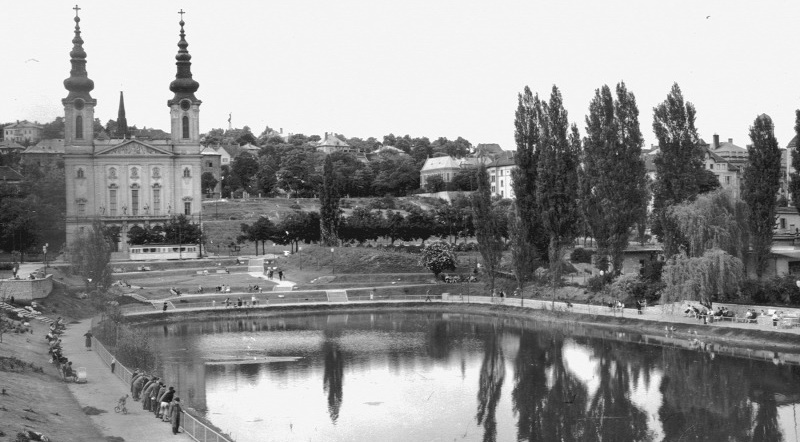
The Bottomless Lake and the surrounding promenade ( Source: Budapest Archives, Reference No.: HU_BFL_XV_19_c_11)
The lake was formerly unofficially called Téglaházi-, Átlós-, Lágymányosi- and Villányi Road Lake, and was also referred to as Háromházi Lake (when there were only three houses near its shore in the middle of the 19th century), but between the two world wars the lake was also called Horthy Miklós Road Lake. The Bottomless Lake, as an official name, dates back to 1938, after the construction of the Cistercians.

The Bottomless Lake in 1960, at the time of its renovation (Source: Budapest Archives, Reference No.: HU_BFL_XV_19_c_11)
The leadership of the capital decided in the 1950s to tidy up the neglected, garbage-filled lake, the surroundings of it and the park. Between 1958 and 1960, the modern image of the Bottomless Lake was created on the basis of the plans and on-site supervision of horticultural engineer Mihály Mőcsényi, and the plans of the western park were noted by horticultural engineer Vilmos Jancsó.
As the planned third building, the convent, next to the Szent Imre High School and the St. Emeric Parish Church was not built in the end, but the pre-fabricated concrete elements for the construction were already there, they used it during the finalisation of the lake bed. At the suggestion of Mőcsényi, the walls of the lake were stabilised with these blocks. The renovation of the lake and the establishment of the park were carried out by the residents of the district in social work on the weekends, but a lot of students also took part, from where the area got the name Youth Park, which is no longer used today. The construction is also captured by a memorial plaque on the lakeside retaining wall.
_Gimnázium_és_a_Szent_Imre_templom_Fortepan_100898.jpg)
The Bottomless Lake in 1969, on its shores is the Park Restaurant, opposite is the Szent Imre High School and St. Emeric Parish Church (Photo: Fortepan/No.: 100898)
At that time, a railing was formed around the lake, piers and reeds were planted around it, trees were also planted in the park, and fish were also put in the lake. The tennis courts were kept in the area, but there were also plans for a restaurant, an open-air cinema and a playground. The essence of the concept was the clean spatial structure and transparency, and the basic goal of the designer Mihály Mőcsényi was to make the St. Emeric Parish Church reflected in the lake and to be an integral part of the park with this view.
As Mőcsényi himself put it:
“My main goal was to make the two-tower church reflected on the surface of the lake offering such an experience that this image, this sight, would become the visual centre and emblem of the district. I tried to make the young and old happy with special field sculptures, beautiful views and intimate garden areas, resting and walking areas bordered by shrubs and trees. I wanted a lot of people to feel like coming to the lake from spring to autumn, relaxing, enjoying the sun, the laugh of the children.”
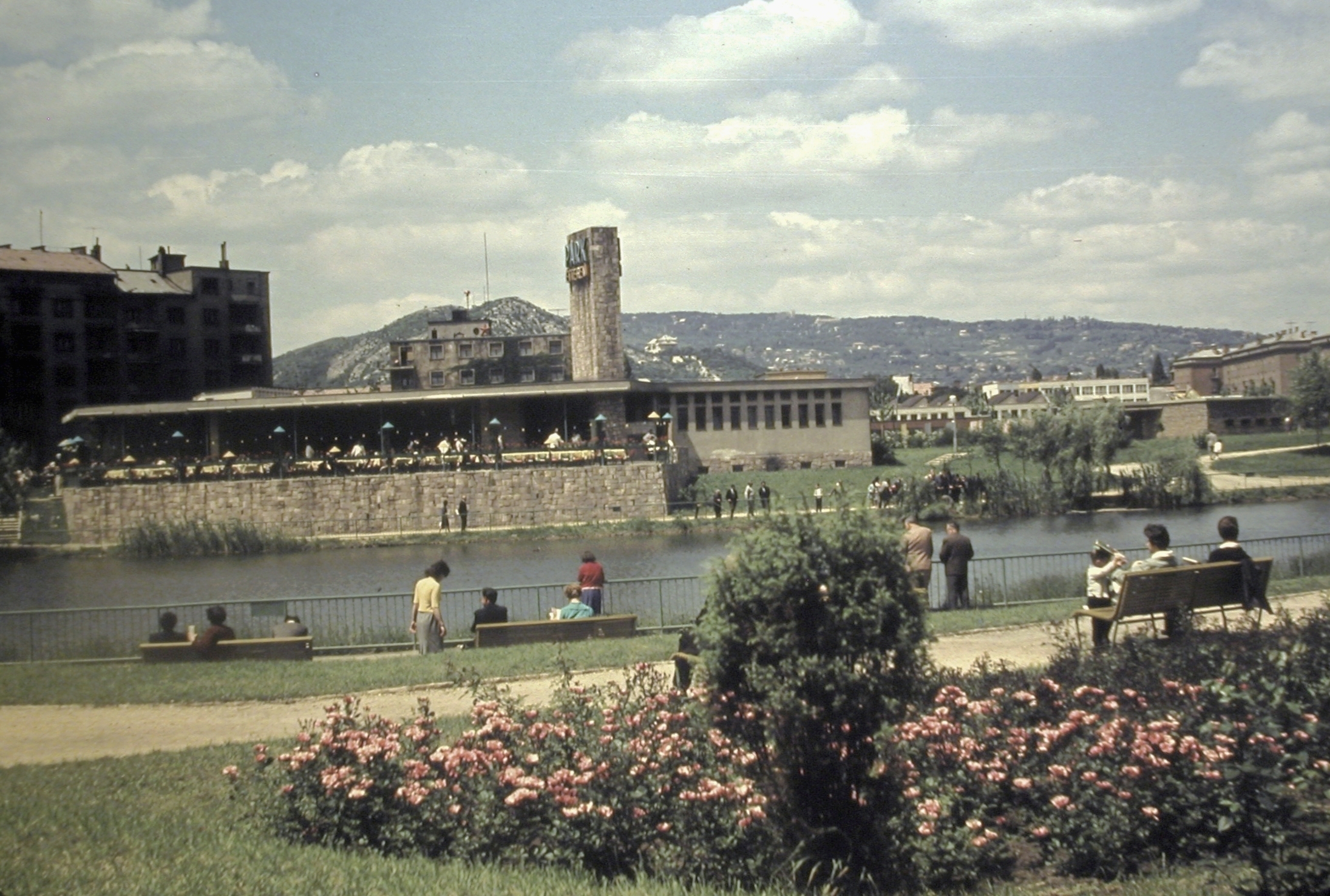
The lake and the Park Restaurant which opened in 1960 (Source: Budapest Archives, Reference No.: HU_BFL_XV_19_c_11)
According to research, the Bottomless Lake has a water content of 40,000 cubic metres, but this water is no longer associated with the stratified water that once erupted. Previously, a small streamlet poured into it from Gellért Hill, but during the 20th century installations, it also disappeared. Its water comes mainly from the rain and the catchment area on the south side of Sas Hill.
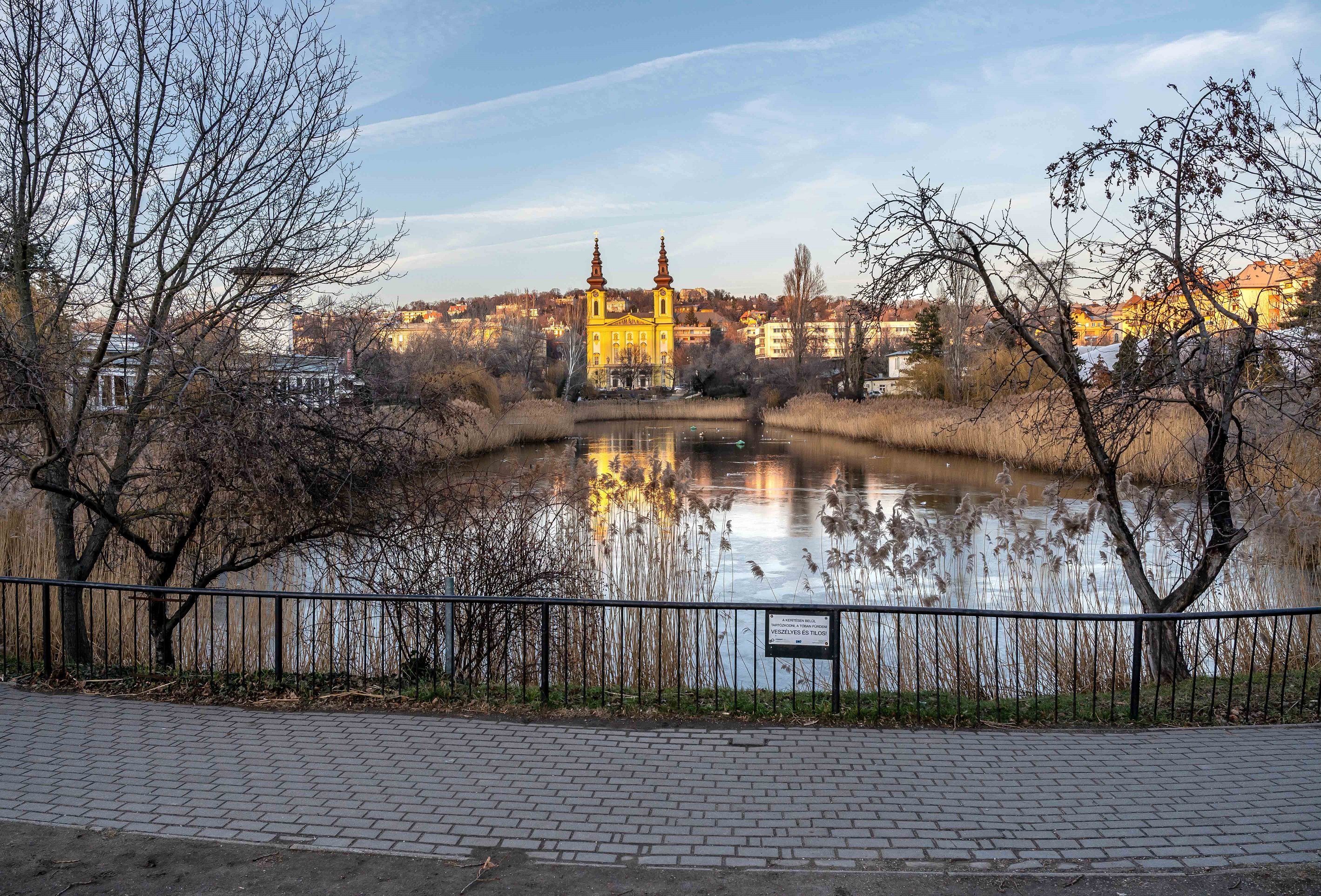
The Cistercian church is reflected in the lake according to the garden architecture concept (Photo: Balázs Both/pestbuda.hu)
During the 20th century, the Bottomless Lake has already become a popular destination for those looking to relax. An aeration device was installed in the lake in the 1980s by the Bottomless Lake Fishing Association to maintain the lake’s wildlife, and fishing was banned in 2010. In 2012, the lake underwent a major maintenance.

Opposite is Bartók Béla Road and its houses (Photo: Balázs Both/pestbuda.hu)
The park around the Bottomless Lake is home to a number of public sculptures. The statue of Dezső Kosztolányi, made by Tibor Borbás in 1979, can be seen directly from Bartók Béla Road. Not far from him, towards the Móricz Zsigmond Square, stands the statue of Béla Bartók, made in 1981 by József Somogyi. The sculpture entitled The Sitting Boy (Az Ülő fiú), the work of Magda Gádor in 1961, was erected on the playground created in 1997. László Molnár's work Teddy Bear and Mihály Dabóczy's Fisher Boy were also made in 1961. In the part of the lake closer to Villányi Road, the 1982 Hungarian Youth Monument of Gyula Illés and Zoltán Gulyás can be seen, then between the church and the lake, a full-length statue of János Boldog Brenner, Cistercian monk adorns the park, the work of Tibor Rieger was inaugurated in 2018.
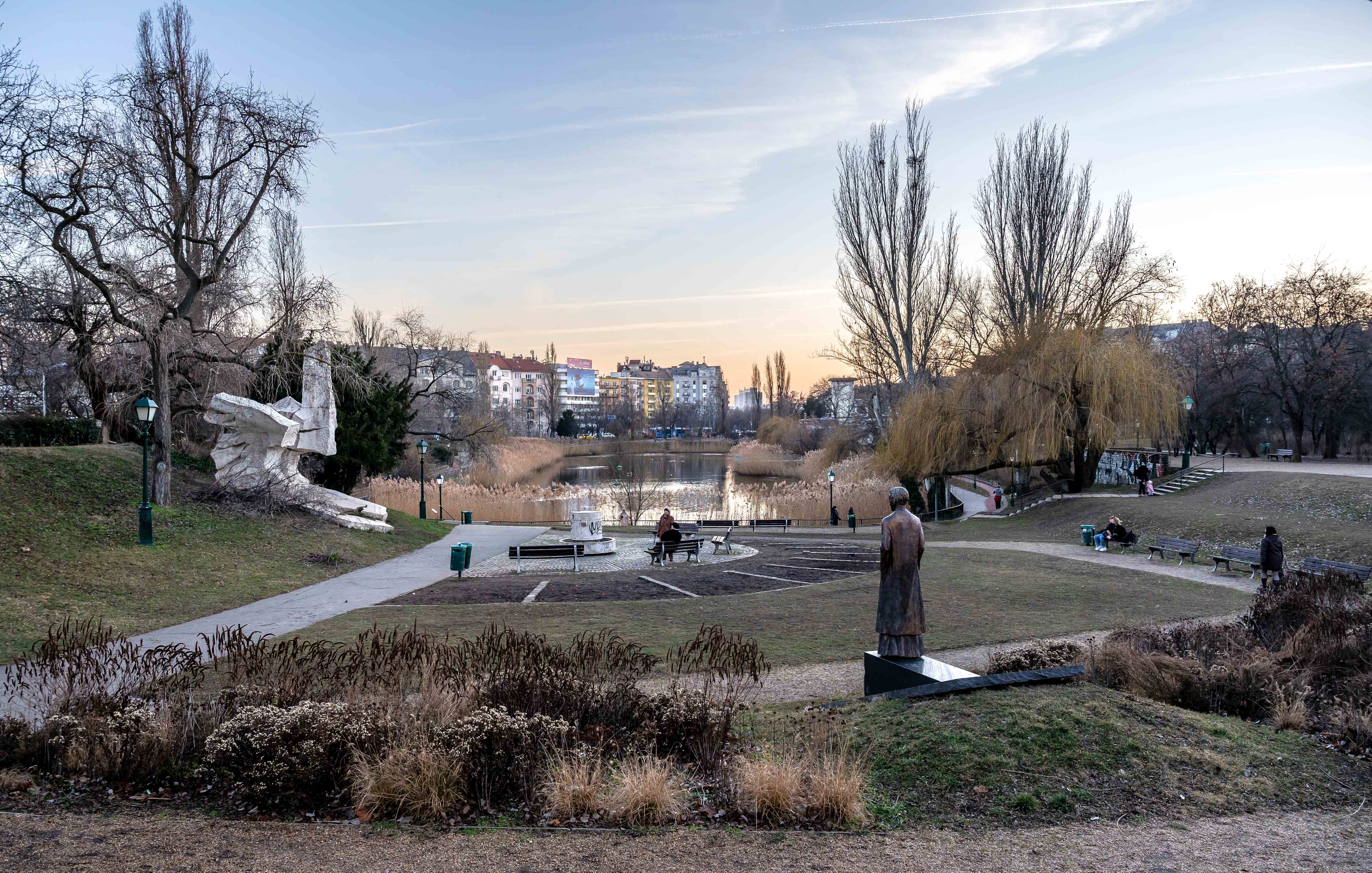
To the left is the Hungarian Youth Monument (Magyar Ifjúság Szabadságfrontja), and the bronze statue depicts the monk János Boldog Brenner (Photo: Balázs Both/pestbuda.hu)
In 2010, the park around the Bottomless Lake was named after Father Olofsson Placid, a Benedictine monk who saw the Gulag, serving in the St. Emeric Parish Church. Another attraction on the site is the Bartók Béla Stage, opened in 1958 on the left bank of the lake, close to Bocskai Road. From 1966, it was named Buda Park Stage, but it has been operating under New Buda Park Stage since 2015.
Cover photo: The Bottomless Lake, opposite is the former Park Restaurant building and St. Emeric Parish Church (Photo: Balázs Both/pestbuda.hu)




































Hozzászólások
Log in or register to comment!
Login Registration